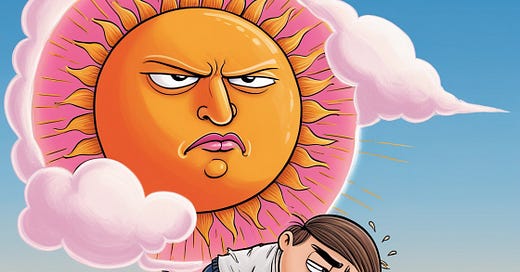Is Daylight Savings Time Killing Us?
Maybe...but doing away with it may have poorly understood costs too.
The clocks have just fallen back and as I lounged around during my extra one hour of time on Sunday, I perused the usual slurry of calls to eliminate Daylight Savings Time (DST) clock resets1. But I also found one article that, sorta, defended them. This article pointed out that, by making Daylight Savings Time permanent (meaning no switches in time in Fall and Spring), winter sunrises wouldn’t come until nearly 9am in some cities2. This would mean kids at bus stops in complete darkness. By contrast, making Standard Time permanent would result in the sun rising around 4am in some northern cities during summer3.
Daylight Savings Time is not an issue I’m particularly passionate about. It helps that, living in Florida, variations in sunrises and sunsets are less dramatic than up north. Also, being a professor is a cushy job, so I can adjust sleep schedules pretty easily. But this defense of the current system intrigued me. It conflicts with arguments that eliminating the Spring/Fall time changes would save lives. Which, of course, got me curious…how strong is the evidence against Daylight Savings Time?
What follows is hardly a systematic literature review to be fair. Nonetheless, this article from 2018 about accident rates I think is pretty typical of what I found. What most people worry about is the hour lost in the Spring…tired people smashing up their cars. Consistent with concerns, car accident rates increase immediately after DST by about 16%. Home and fall accidents increased prior to DST which they interpreted as anticipatory, but which I find less convincing as an explanation. Why would one fall in anticipation of DST? There seemed to be no impact on work accidents.
So…I dunno. I get the argument, but this feels a bit like weak sauce. A 16% increase in accidents sounds kind of serious and I don’t want to dismiss that, but on the other hand, I generally find percentile increases in research data below 40-50% to be pretty unreliable, so this could be just noise. The fact they found a strange “anticipatory” effect prior to DST again suggests there’s noise in this data.
Another study found somewhat opposing results. Specifically, across European countries that participate in DST, they found that mortality rates blipped up following the fall time switch with a decrease in mortality after the spring switch (and yes, I had to read that several times to make sure I’d hadn’t gotten it wrong). This is pretty much the opposite outcome from what other studies have indicated. For instance, another study from Australia, found that heart attack risk increased after the spring change, and decreased after the fall change. These effect sizes too seemed to be pretty small making me wary about the reliability behind broad causal claims.
Another study suggested that suicides are more common during the DST phase, meaning the entire eight months or so between March and November. However, this seemed to be particularly true between July through October, so it felt like it was a stretch to attribute this to DST. Maybe it’s just too cold to kill yourself in winter? Who knows?
Again, this post is hardly a meta-analysis. But I found myself a bit dissatisfied with this evidence base. But here’s the other problem I have…it feels like there may be survivor bias in this literature. Let’s assume for argument that making DST permanent would save hundreds of lives a year based on these studies. What we don’t know is the mortality costs of making DST permanent.
Most studies look specifically at day-to-day changes surrounding the specific fall and spring time switches. That’s very fair, don’t get me wrong. But if you’re going to have a heart attack because you lost an hour of sleep let’s admit…you were circling the bowl anyway. Maybe some of those deaths would still have happened but have been spread out over more days.
The traffic deaths data is more convincing, assuming it’s not noise. But what’s harder to assess is the costs of making DST permanent. If we save a few hundred lives in March…how many kids also get run over at dark bus stops between November and February? How many early-morning accidents happen that would have been prevented had sunrise only occurred an hour earlier? I think that’s kind of hard to know…presumably it could be done via some kind of randomized trial in which some countries abandoned DST and others didn’t…then look at wintertime traffic mortality over, what, a decade or so to have adequate data?
Ultimately, I really don’t care that much about DST. I’ve got plantation shutters and a job where I can stroll into the office at 11. But I’d like to see some better data and people being more cautious about how they sell it.
I am going to generally refer to Daylight Savings Time or DST when referring to the current system of resetting the clocks in Fall and Spring. I understand there are calls to make either DST (meaning time set ahead) or Standard Time permanent. So if I refer to making DST permanent, I mean sticking with the hour ahead and never changing it back.
This is particularly true for cities up north, but also those toward the west end of their time zone, like Atlanta.
Growing up in Rhode Island, I don’t seem to remember this very much. However, I led several study abroads to London during summers more recently. Multiple times I awoke to a full sunrise at like 4-5am thinking my alarm had failed and I’d missed my class, only to realize I had hours left to sleep. Those early sunrises are absurd and truly suck.




